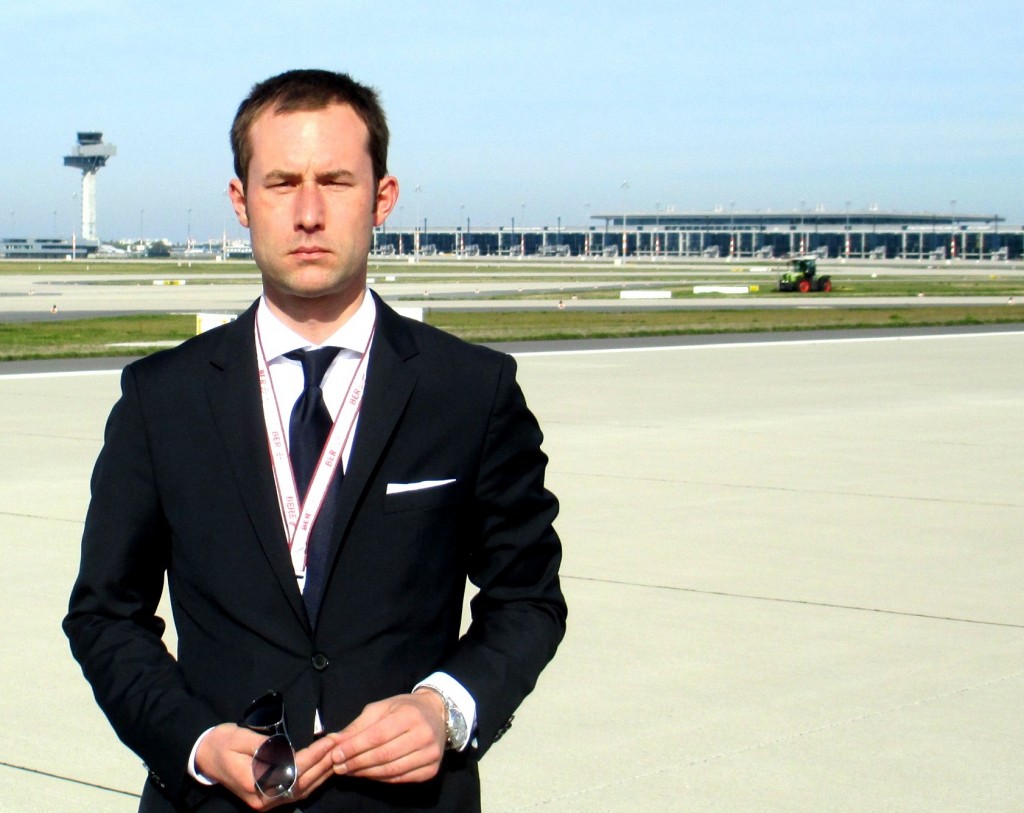
Roadway leading to new terminal building at Berlin Brandenburg Willy Brandt Airport (photo courtesy Alexander Obst, Marion Schmieding / Flughafen Berlin Brandenburg GmbH )
BY RON BERNTHAL
The year 2014 will mark the 25th anniversary of the fall of the Berlin Wall, and one aspect of the quarter century anniversary since Berlin was unified was going to be the opening of the city’s new airport, known as Berlin Brandenburg Airport Willy Brandt.
Mr. Brandt, who died in 1992, was mayor of West Berlin when the Berlin Wall was constructed, and won the Nobel Peace Prize in 1971 during his term as chancellor of Germany. The airport, which had planned to open in 2011, is now expected to open in 2016, after several multi-year delays. Although German optimists are still saying “Was lange währt wird endlich gut” (Good things come to those who wait), patience is wearing thin among Germany’s tourism and airline officials.
When the new airport finally opens it will replace Tegel Airport, a former military site during World War II that opened as a city airport in 1948 by the western powers governing Berlin at that time. Tegel is just a few miles from downtown Berlin, a great convenience for city residents, politicians, visiting business travelers and tourists, but it has become heavily congested with air traffic and passengers as Berlin has grown since unification into a thriving and popular capital city.

New terminal gates are ready to accept the largest aircraft once the airport opens in 2015. (photo Ron Bernthal)
“When we decided to build the new airport, located about 15 miles south of the city, there was no talk about putting it near the city center. The capacity of the new airport will be twice what Tegel and the smaller charter airport [Schoenfield] can currently handle together,” said Lars Wagner, a spokesperson for the new Berlin Brandenburg Airport. “We needed lots of new space, and we have that now, and with a modern terminal connected to a new, deluxe hotel and high speed rail station, and with the newest control tower in Europe, the airport will greatly enhance a visitors experience flying into and out of the city.”

Lars Wagner, Berlin Airport spokesperson, says the airport will be able to handle 45 million passengers annually in the years ahead. (photo Ron Bernthal)
The problem, of course, is that Berliners have been waiting for over three years for the airport to open as one delay led to another. The terminal looks ready to accept passengers, the runways are smooth and fully paved, a 216-foot control tower overlooks the field and the Brandenburg countryside, and a beautifully designed four-star Steigenberger Airport Hotel Berlin sits across from the terminal, its 322 rooms, lobby and restaurant all shuttered and quiet. Yet, German airport authorities must keep the airport closed until they can solve the last few technical and fire prevention issues.
Many German and European investors who bought land, constructed restaurants, small hotels, shops and other businesses around the new airport are pulling their hair out at the thought of losing more potential revenue from another delayed opening, and Berlin tourism officials and airlines with scheduled service into Berlin are again scaling down grand opening plans.

Rendering of new Steigenberger Hotel and airport terminal in background (image courtesy Günter Wicker Flughafen Berlin Brandenburg)
In a casual, but typical, Berlin way of looking at things, many local residents are taking the postponements in stride. After all, this is a city that suffered terribly for 50 years after the Second World War, with half the population living on the wrong side of the Berlin Wall, in communist East Berlin, for 28 of those years. What’s another 12 months or so having to use a small and congested airport? Although the German reputation for efficiency and engineering performance — think Mercedes, Porsche, BMW, Leica – may have lost some luster, and most big building projects in Germany are completed on time, the new airport will be worth waiting for.
When Berlin Brandenburg Airport does open it will handle 27 million passengers per year, and is equipped to accommodate 45 million annual passengers in the decades ahead. The cost of the new airport project has risen to about $6.5 billion and counting (even the maintenance costs while the last technical problems are ironed out are huge), but the terminal, control tower and high-tech energy systems are state-of-the-art, and a new train station has been constructed underneath the six story terminal building, linking the airport to downtown Berlin’s Hauptbahnhof (Central Station) in less than 20 minutes using high speed trains. The German architectural firm that designed the terminal building also designed the iconic glass and steel Hauptbahnhof, and the distinctive use of these building materials is carried over to the new airport as well. Because of the terminal’s unique design, passengers will be able to access both domestic and international flights from one building. Inside the terminal the designers used wood paneling which will make for a softer and quieter passenger experience.
“Yes, we are disappointed that the airport is not yet open, but it will be great for business and leisure passengers flying to Berlin when it does open” said Madeleine Vogelsang, a spokesperson for airberlin, which maintains its European hubs in Berlin and Dusseldorf, Germany. “Our airline is looking forward to providing international and domestic services into Berlin Brandenburg, as it will mean much less congestion in the terminal and customs areas, and allow our trans-Atlantic and European connecting passengers a fast and efficient transit experience. We are prepared to move our entire Berlin flight operations from Tegel to the new airport as soon as we are given the green light. ”
Berlin airport officials are, of course, very cautious these days about giving the “green light” to open the airport. They want to be confident that the next opening date announcement will be the last one.



